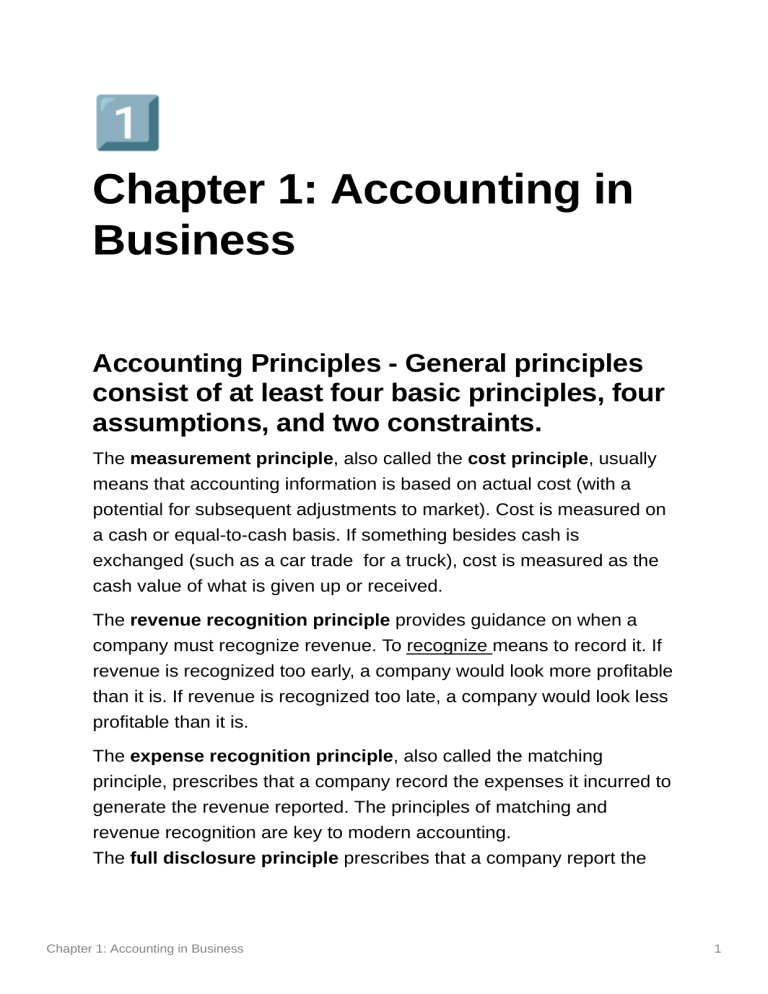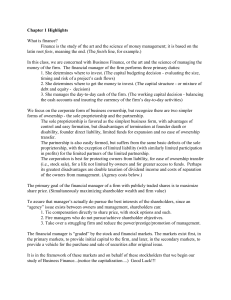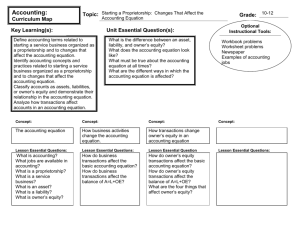
Chapter 1: Accounting in Business Accounting Principles - General principles consist of at least four basic principles, four assumptions, and two constraints. The measurement principle, also called the cost principle, usually means that accounting information is based on actual cost (with a potential for subsequent adjustments to market). Cost is measured on a cash or equal-to-cash basis. If something besides cash is exchanged (such as a car trade for a truck), cost is measured as the cash value of what is given up or received. The revenue recognition principle provides guidance on when a company must recognize revenue. To recognize means to record it. If revenue is recognized too early, a company would look more profitable than it is. If revenue is recognized too late, a company would look less profitable than it is. The expense recognition principle, also called the matching principle, prescribes that a company record the expenses it incurred to generate the revenue reported. The principles of matching and revenue recognition are key to modern accounting. The full disclosure principle prescribes that a company report the Chapter 1: Accounting in Business 1 details behind financial statements that would impact users’ decisions. Those disclosures are often in footnotes to the statements. Assumptions The going-concern assumption means that accounting information reflects a presumption that the business will continue operating instead of being closed or sold. The monetary unit assumption means that we can express transactions and events in monetary, or money, units. Money is the common denominator in business. Examples of monetary units are the dollar in the United States, Canada, Australia, and Singapore; and the peso in Mexico, the Philippines, and Chile. The monetary unit a company uses in its accounting reports usually depends on the country where it operates, but many companies today are expressing reports in more than one monetary unit. The time period assumption presumes that the life of a company can be divided into time periods, such as months and years, and that useful reports can be prepared for those periods. The business entity assumption means that a business is accounted for separately from other business entities, including its owner. The reason for this assumption is that separate information about each business is necessary for good decisions. A business entity can take one of three legal forms: proprietorship, partnership, or corporation. 1. proprietorship, is a business owned by one person. It is a separate entity for accounting purposes, but it is not a separate legal entity from its owner. This means, for example, that a court can order an owner to sell personal belongings to pay a proprietorship’s debt. This unlimited liability of a proprietorship is a disadvantage. However, an advantage is that a proprietorship’s Chapter 1: Accounting in Business 2 income is not subject to a business income tax but is instead reported and taxed on the owner’s personal income tax return. 2. A partnership is a business owned by two or more people, called partners. like a proprietorship, is not legally separate from its owners. This means that each partner’s share of profits is reported and taxed on that partner’s tax return. It also means unlimited liability for its partners. However, at least three types of partnerships limit liability. A limited partnership (LP). A limited liability partnership (LLP) . A limited liability company (LLC) offers the limited liability of a corporation and the tax treatment of a partnership (and proprietorship). Most proprietorships and partnerships are now organized as LLCs. 3. A corporation is a business legally separate from its owners, meaning it is responsible for its own acts and its own debts. A corporation acts through its managers, who are its legal agents. Separate legal status also means that its owners, who are called shareholders (or stockholders), are not personally liable for corporate acts and debts. This limited liability is its main advantage. A main disadvantage is what’s called double taxation —meaning that (1) the corporation income is taxed and (2) any distribution of income to its owners through dividends is taxed as part of the owners’ personal income, usually at the 15% rate. Accounting Constraints There are two basic constraints on financial reporting. The materiality constraint prescribes that only information that would influence the decisions of a reasonable person need be disclosed. This constraint looks at both the importance and relative size of an amount. The costbenefit constraint prescribes that only information with benefits of disclosure greater than the costs of providing it need be disclosed. Chapter 1: Accounting in Business 3 ASSETS = LIABILITIES + EQUITY Assets liabilities equity cash accounts payable owner, capital accounts receivable notes payable owner, withdrawal notes receivable unearned revenue revenue inventory accrued liabilities expenses prepaid accounts supplies land equipment buildings patents Net income occurs when revenues exceed expenses. Net income increases equity. A net loss occurs when expenses exceed revenues, which decreases equity. Chapter 1: Accounting in Business 4 Financial statement Income statement—describes a company’s revenues and expenses along with the resulting net income or loss over a period of time due to earnings activities. Statement of owner’s equity—explains changes in equity from net income (or loss) and from any owner investments and withdrawals over a period of time. Balance sheet—describes a company’s financial position (types and amounts of assets, liabilities, and equity) at a point in time. Chapter 1: Accounting in Business 5 Statement of cash flows—identifies cash inflows (receipts) and cash outflows (payments) over a period of time. Chapter 1: Accounting in Business 6






